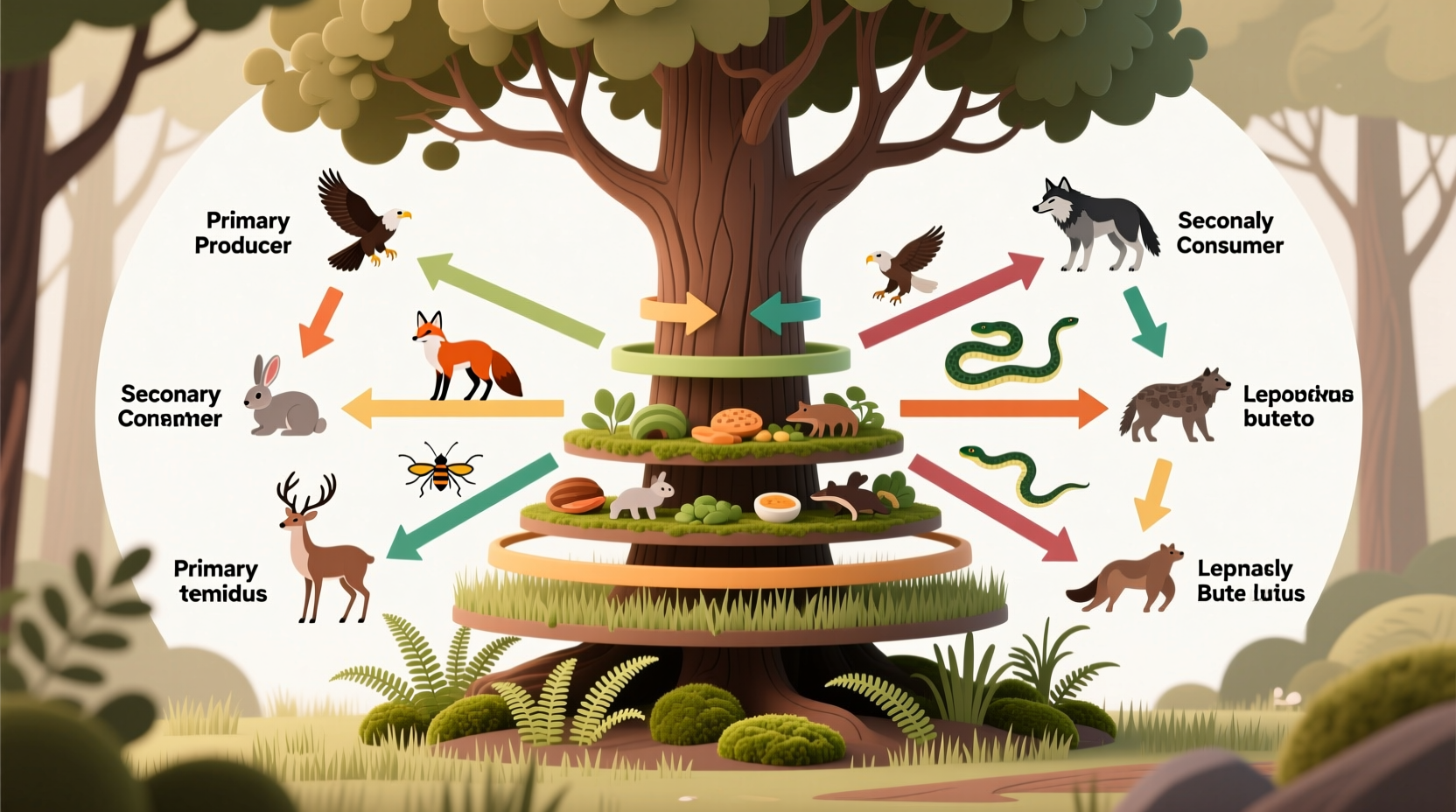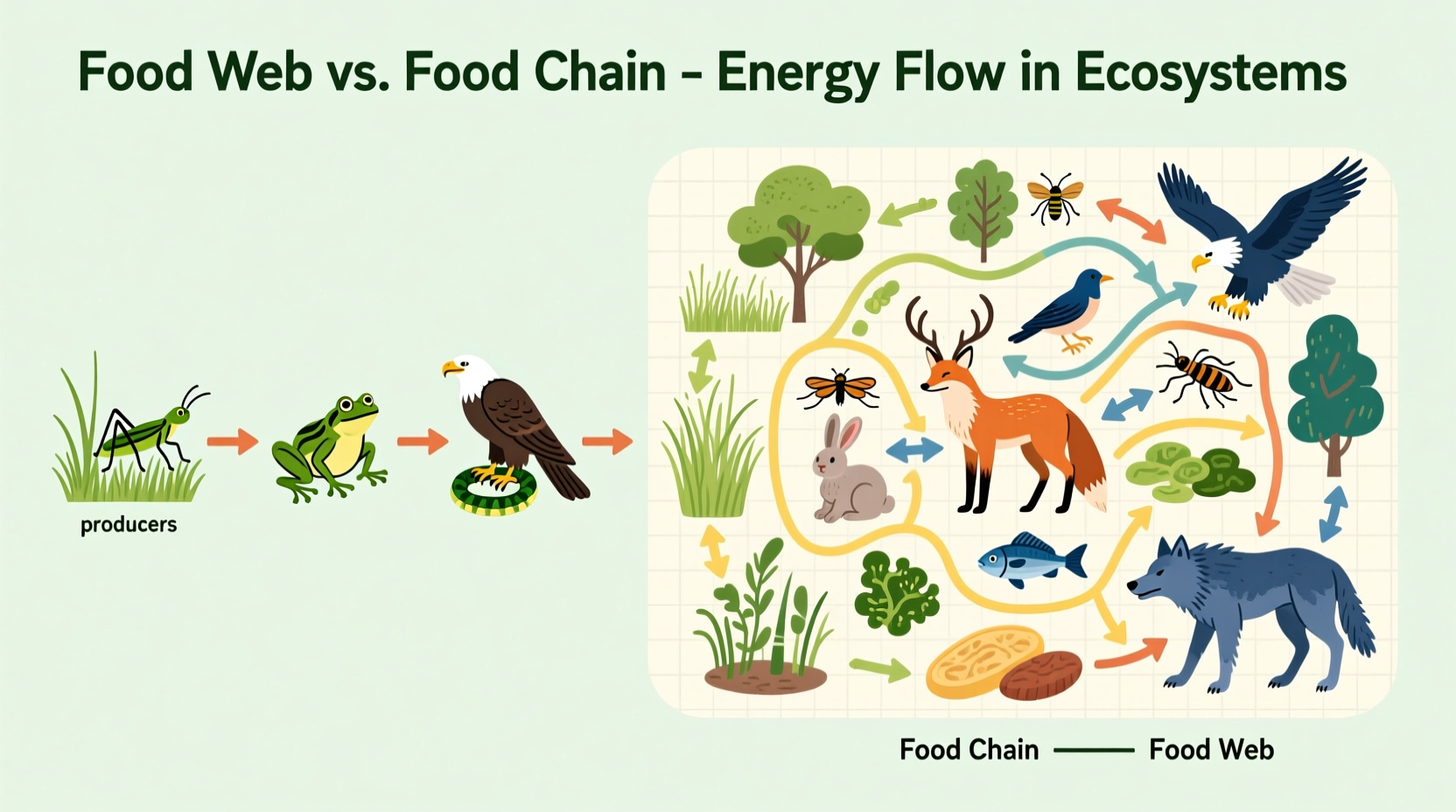Understanding ecological relationships is fundamental to grasping how ecosystems function and maintain balance. When students and nature enthusiasts search for how is a food web different from a food chain, they're seeking clarity on two foundational concepts in ecology that are often confused. This comprehensive explanation delivers exactly what you need: a clear distinction between these models, practical examples you can visualize, and insights into why both concepts matter for understanding real-world ecosystems.
Breaking Down the Basic Concepts
Before examining their differences, let's establish what each term means in ecological science. These definitions form the foundation for understanding ecosystem dynamics and energy flow.
What Is a Food Chain?
A food chain represents a single, linear pathway of energy transfer through an ecosystem. It follows a straightforward sequence: from the sun to producers (like plants), then to primary consumers (herbivores), followed by secondary consumers (carnivores), and sometimes tertiary consumers (top predators). Each step in this sequence is called a trophic level.
Consider this simple example:
Sun → Grass → Grasshopper → Frog → Snake → Hawk
This linear model shows how energy moves from one organism to the next in a direct sequence. Food chains provide a simplified view that helps us understand basic energy transfer principles but fails to capture ecosystem complexity.
What Is a Food Web?
In contrast, a food web demonstrates the interconnected network of multiple food chains within an ecosystem. It reveals how most organisms consume and are consumed by multiple species, creating a complex web of feeding relationships.
Using the same organisms from our previous example, a food web would show:
- Grass being eaten by grasshoppers, rabbits, and deer
- Grasshoppers being eaten by frogs, birds, and spiders
- Frogs being eaten by snakes, birds, and fish
- Snakes being eaten by hawks and foxes
This interconnected model better represents the reality of ecological relationships where organisms typically have multiple food sources and predators.
| Feature | Food Chain | Food Web |
|---|---|---|
| Structure | Linear, single pathway | Complex network of interconnected chains |
| Realism | Simplified model | More accurate representation of ecosystems |
| Stability Insight | Shows vulnerability (one break collapses the chain) | Demonstrates resilience (multiple pathways maintain flow) |
| Energy Flow | Single-direction pathway | Multiple interconnected pathways |
| Organism Relationships | Each organism has one predator and one prey | Organisms have multiple predators and prey options |
| Usefulness | Educational tool for basic concepts | Scientific tool for ecosystem analysis and conservation |
Visualizing the Difference: A Practical Example

Imagine a forest ecosystem. A food chain might show:
Oak Tree → Squirrel → Fox → Eagle
However, in reality, squirrels also eat mushrooms and bird eggs. Foxes eat rabbits and birds. Eagles hunt snakes and small mammals. This interconnected feeding pattern forms a food web that demonstrates ecosystem complexity.
According to research from the National Geographic Society, ecosystems with more complex food webs demonstrate greater resilience to environmental changes. When one species declines, organisms can often switch to alternative food sources, preventing ecosystem collapse.
Why Food Webs Provide a More Accurate Picture
The evolution of ecological understanding reveals why scientists moved from relying solely on food chains to embracing food webs as the standard model. Early ecologists in the 1920s primarily used food chains to explain energy flow. However, by the 1950s, researchers like Charles Elton recognized that ecosystems functioned as interconnected networks.
Food webs better represent three critical ecological realities:
- Multiple feeding relationships: Most consumers eat more than one type of food and are eaten by multiple predators
- Ecosystem stability: When one species declines, food webs allow energy to flow through alternative pathways
- Nutrient cycling: Food webs illustrate how nutrients move through various pathways before returning to the soil
A study published in Nature Ecology & Evolution demonstrated that ecosystems with higher food web complexity maintained 37% greater species diversity during environmental disturbances compared to simplified models.
When Each Model Is Most Useful
While food webs provide a more comprehensive view, both models serve valuable purposes depending on the context:
Food Chains: Best Applications
- Teaching basic ecological concepts to beginners
- Studying specific toxin pathways (like mercury biomagnification)
- Analyzing energy transfer efficiency between trophic levels
Food Webs: Best Applications
- Conservation planning and biodiversity assessments
- Predicting ecosystem responses to species extinction
- Understanding invasive species impacts on native ecosystems
- Climate change impact modeling on ecological communities
Researchers at the US Geological Survey emphasize that food web analysis has become essential for predicting how ecosystems will respond to environmental changes, making it a critical tool for modern conservation efforts.
Common Misconceptions Clarified
Several misunderstandings frequently arise when comparing these concepts:
- Misconception: Food chains don't exist in nature
Reality: Food chains represent specific pathways within the larger food web - Misconception: Food webs are just multiple food chains combined
Reality: Food webs reveal emergent properties like stability and resilience that individual chains cannot demonstrate - Misconception: More complex food webs are always better
Reality: While complexity generally increases stability, extremely complex webs can become vulnerable to cascading effects
Practical Implications for Ecosystem Management
Understanding the difference between food chains and food webs isn't just academic—it has real-world applications:
When conservationists removed wolves from Yellowstone National Park in the early 20th century, they disrupted a critical node in the food web. This seemingly simple change triggered a trophic cascade where elk populations exploded, overgrazing vegetation, which in turn affected beavers, songbirds, and even river morphology. The reintroduction of wolves in 1995 demonstrated how restoring one species can rebalance an entire food web—a phenomenon that a simple food chain model couldn't predict.
Today, environmental scientists use food web analysis to:
- Identify keystone species critical to ecosystem stability
- Predict impacts of climate change on species interactions
- Develop more effective conservation strategies
- Assess risks of introducing non-native species
As the Encyclopedia Britannica explains, "The food web provides a more complete picture of the structure and dynamics of ecosystems than does a food chain. The concept of food webs has been instrumental in understanding how ecosystems function and how disturbances can affect ecosystem stability."
Key Takeaways for Students and Nature Enthusiasts
When studying ecological relationships, remember these essential points about how is a food web different from a food chain:
- Food chains show single-direction energy flow; food webs show interconnected pathways
- Food chains are simplified models; food webs reflect ecosystem complexity
- Food webs demonstrate ecosystem resilience through multiple feeding relationships
- Both models serve different purposes in ecological study and conservation
- Real ecosystems operate as food webs, with food chains representing specific pathways
By understanding these differences, you'll gain deeper insights into how ecosystems maintain balance and respond to environmental changes—a crucial perspective for anyone interested in ecology, conservation, or environmental science.











 浙公网安备
33010002000092号
浙公网安备
33010002000092号 浙B2-20120091-4
浙B2-20120091-4